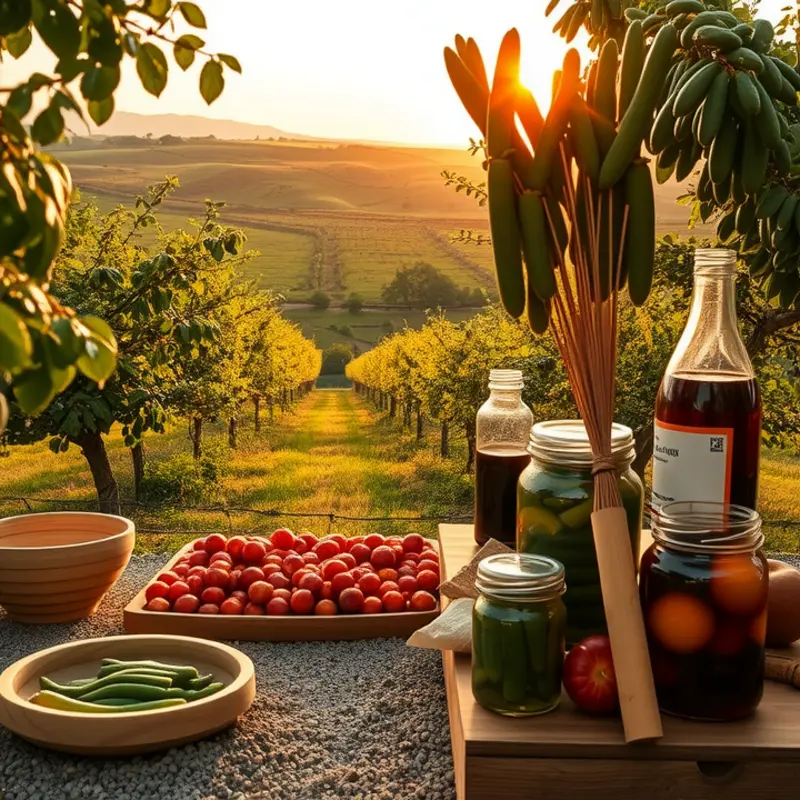Embark on a tantalizing journey through time as we explore ancient food pairings that have transcended cultures and timelines. From the fiery spice roads of Asia to the aromatic markets of the Mediterranean, discover how ancient civilizations crafted their meals and developed beloved flavor combinations that still resonate today. This exploration showcases not only the ingredients, but also the stories and traditions behind these harmonious unions.
The Spice Routes: Embracing Bold Flavors

Along the ancient spice routes, caravans were laden with treasures that would transform culinary landscapes forever. Spices like saffron, cumin, and cinnamon were more than mere ingredients; they were powerful agents of cultural exchange that inspired innovation in kitchens across continents.
The Romans were among the earliest to embrace these aromatic gems. They imported exotic spices from India and the Far East, integrating them into their feasts. Cumin was particularly popular, adding depth to a variety of meats and stews. The Roman appetite for spices was insatiable; they believed these elements not only enhanced flavor but also had medicinal properties, echoing a sentiment still prevalent in various cultures today.
Arab traders played a crucial role in this aromatic journey, acting as intermediaries between the Spice Islands and the bustling markets of the Mediterranean. Saffron, cherished for its golden hue and delicate taste, became a staple in Arab cuisine. It paired beautifully with rice, a combination that evolved into dishes like pilaf—a precursor to today’s globally recognized biryanis and paellas.
Tagines are another testament to the impact of the spice routes. The slow-simmered Moroccan stew, brimming with a medley of dried fruits, nuts, and spices, exemplifies the alchemical potential of merging various flavor profiles. Each ingredient complements and contrasts the other, creating a harmonious balance that tantalizes taste buds and signifies culinary artistry.
The interplay of spices also had significant social and economic implications. Not only did they dictate trade routes, but they also became symbols of wealth and status. Kings and emperors used spices in their banquets to flaunt affluence and distinguish themselves with unique blends unavailable to ordinary citizens.
These bold combinations made their mark beyond culinary satisfaction. They were entwined with rituals, celebrations, and daily life, reflecting the values and beliefs of civilizations. Each meal prepared with these spices was not just food but a narrative of cultural identity and a testament to human ingenuity.
Today, our kitchens continue to echo the legacy of these ancient routes. The same spices still inspire chefs and home cooks alike, inviting us to explore global cuisines deeply rooted in history. To learn more about the global influence of trade on culinary traditions, you might find this article on Culinary Influences & Trade insightful.
As we savor these historic pairings, we are reminded of the power of flavors to foster connection and understanding across cultures, proving that food is indeed a universal language.
Fermentation and Preservation: The Art of Pairing

Fermentation is a transformative art that ancient cultures perfected, using it not only as a method of preservation but also to deepen the flavors of their cuisines. This technique allowed societies to unlock the umami essence in everyday ingredients, creating complex dishes that were as practical as they were delicious.
In East Asia, soybeans, rich in protein, were fermented into condiments like miso and soy sauce, which imbue dishes with a depth and savory taste unmatched by fresh ingredients. Miso, traditionally made by fermenting soybeans with salt and koji, a special type of mold, is a staple in Japanese cuisine. It’s used not only in soups but also in marinades and dressings, providing a nuanced flavor profile. Similarly, soy sauce, made by fermenting soybeans with wheat, is a cornerstone of Chinese, Japanese, and Korean culinary practices. It acts as a natural flavor enhancer, balancing out the palate in stir-fries and dipping sauces.
In Europe, cabbage’s transformation into sauerkraut is a testament to the continent’s enthusiastic adoption of fermentation. This tangy, preserved vegetable was first made by the Chinese over two thousand years ago, and it traveled to Europe where it became indispensable, especially in Central and Eastern cuisines. The lactic acid bacteria involved in sauerkraut fermentation not only preserved the cabbage through the winter but also added a complex, sour taste that complemented meats and potatoes brilliantly.
Pickling, another ancient preservation technique, showcases the ingenious ways diverse cultures approached food longevity. In the Middle East, the technique of pickling, especially with vinegars and brines, was traditionally used to preserve cucumbers, turning them into crisp, flavorful delights commonly known as pickles. Astringent and tangy flavors of these pickles cut through the richness of meats and enhance the overall flavor profile of a meal.
These preservative techniques have retained their importance through millennia, shaping cuisines and migration of flavors across borders. Many contemporary cooks rely on these methods to create dishes that are both modern and steeped in tradition. When miso is used in innovative ways or when a side of sauerkraut appears in modern fusion dining, it reveals the timeless relevance of these practices.
For those looking to expand their cooking techniques with easy-to-make fermented foods, practical advice about home fermentation can be incredibly helpful. Eco-smart kitchen storage can further enhance the sustainability of maintaining these ancient practices.
Ancient ferments’ vibrant flavors and storied past are reminders of how necessity and curiosity drove culinary arts. As our palates continue to evolve, the influence of these traditional fermentation methods persists, promising umami-rich tastes for future generations to adore.
Final words
Ancient food pairings provide invaluable insights into the culinary traditions that have shaped cultures around the globe. From the zest of spices enlivening dishes to the tang of fermented foods enhancing flavors, these culinary marriages tell stories of exploration, trade, and innovation. As food enthusiasts, looking back at these timeless pairings not only enriches our palate but also deepens our appreciation for the diverse tapestry of global cuisine. Embrace these ancient legacies in your kitchen, experimenting with pairings that have stood the test of time.








